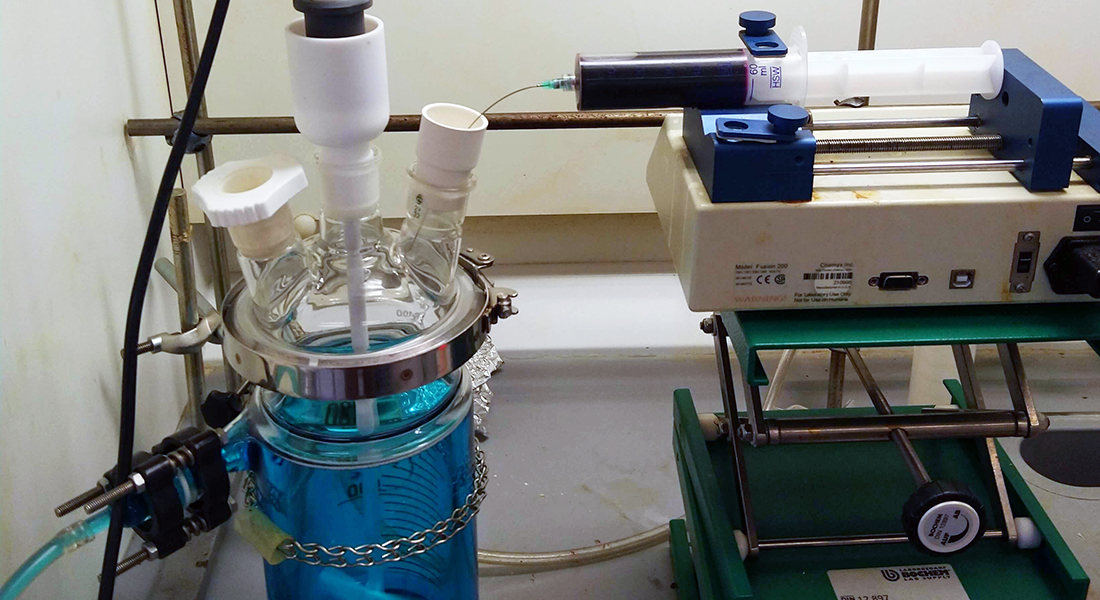
Applied Organic and Macromolecular Chemistry – Christensen group
We are designing and synthesizing molecules for applications in nanomedicine and microbiology (both small molecules and synthetic macromolecules). Small molecules are molecules weight below 500 Dalton, which covers the majority of drugs used today. Macromolecules are larger molecules and typical examples are proteins and polymers. Proteins are typically synthesized in biological systems and are well-defined macromolecules compared to polymers, which are mixtures of compounds with similar structure differing in molecular weight. Well-defined synthetic macromolecules are interesting for applications in nanomedicine – they can be used for drug-delivery or they can be drugs, but the methods for their synthesis is lacking behind.
Some of our products are made for biological testing so the concepts of scalability and batch-to-batch reproducibility are key- elements – to quote a collaborator “it is useless if it doesn’t work in a pig” – and a pig can be a fairly big animal!
Or to quote the Nobel laureate John W. Cornforth: “It is no good offering an elegant, difficult and expensive process to an industrial chemist, whose ideal is something to be carried out in a disused bathtub by a one-armed man who cannot read, the product being collected continuously through the drain-hole in 100 per cent purity and yield”
Two examples of ongoing projects are:
Photodynamic Therapy (PDT) for treatment of Aetherosclerosis (HomePage - CosmoPHOS-nano)
Aetherosclerosis (causing cardiac arrest) is the main cause of premature death in Europe and North America. There is no treatment only palliative treatment (bypass, stents, balloon expansion..). In this project, we developed the first nanoparticle capable of targeting the inflammated plaques causing the problems allowing for diagnostics and treatment with photodynamic therapy. Projects in this area could be synthesis of dendrimers or synthesis of new reagents for PDT, which can used treatment of other diseases as well.
New Antibiotics
Resistance towards antibiotics has been growing for a long time and some microbiologists claim that “we are living in the post-antibiotic ages now”, where more and more infections become untreatable. We discovered a couple of years ago a new type of antibiotics in a collaboration with Rikke Heidemann Olsen from Department of Veterinary and Animal Science, KU. We were looking for new bacterial efflux-pump inhibitors but found something else by serendipity. A project in this area would be synthesis of new potentially active compounds, which are subsequently tested for activity. We are especially interested in finding active compounds, that are fluorescent in order to locate the compounds in the bacteria and finding the mode of action.
Selected publications:
1: “Dendrimer end-terminal motif-dependent evasion of human complement and complement activation through IgM hitchhiking”, L. P. Wu, M. Ficker, J. B. Christensen, D. Simberg, P. N. Trohopoulos, S. M. Moghimi, Nature Communications 12, 4858 (2021)
2: “Complexes of Indomethacin with 4-Carbomethoxy-pyrrolidone PAMAM Dendrimers Show Improved Anti-inflammatory Properties and Temperature-Dependent Binding and Release Profile”, M. Ficker, M. J. M. Theeuwen, A. Janaszewska, M. Gorzkiewicz, S. W. Svenningsen, B. Klajnert-Maculewicz, J. B. Christensen, Molecular Pharmaceutics 15, 3573-3582 (2018)
3: “A new phenothiazine derivate is active against Clostridioides difficile and shows low cytotoxicity” T. Ronco, F. M. Aragao, L. Saaby, J. B. Christensen, A. Permin, A. R. Williams, S. M. Thamsborg, Rikke H. Olsen, PLOS ONE 16, e0258207 (2021)
4: “Insight Into the Anti-staphylococcal Activity of JBC 1847 at Sub-Inhibitory Concentration”
- Ronco, L. H. Kappel, M. F. Aragao, N. Biagi, S. Svenningsen, J. B. Christensen, A. Permin, L. Saaby, K. Holmstrøm, J. K. Klitgaard, A. J. Sabat, V. Akkerboom, M. Monaco, M. Tinelli, A. W. Friedrich, B. Jana, R. H. Olsen, Frontiers in Microbiology 12, 786173 (2022)
